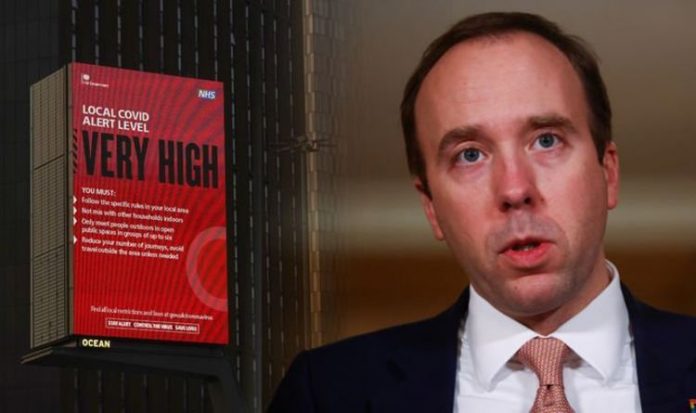Across England, tiered restrictions are in place, with areas classed as medium, high or very high risk. The nationwide lockdown ended on December 2, and bolstered tier restrictions were brought in. Much of the country is currently in either Tier 2 or Tier 3, however, some areas are of “concern” according to Health Secretary Matt Hancock as cases of coronavirus appear to be rising.
England’s chief medical officer has also warned the public to be “very, very sensible” and not go “too far” over Christmas as it is a risky period for coronavirus.
Speaking at the Downing Street press conference on Thursday, Professor Chris Whitty said the combination of rising Covid-19 infection rates in some areas, the Christmas period and winter pressures on the NHS painted a “concerning picture”.
Coronavirus restrictions are due to be relaxed across the UK between December 23 and 27 to allow families to form bubbles and spend some limited time together over the festive period.
However, before Christmas, there will be a review into the Tier system, with some areas potentially moving up, or down, the tiers.
Read More: Covid vaccine and fertility: No evidence vaccine impacts fertility
Will London enter Tier 3?
Londoners have been urged to “follow the rules” as cases have been rising across the capital.
Data from Public Health England (PHE) suggested the capital now had 191.8 coronavirus infections per 100,000 people in the week to December 6.
The figure is higher than regions already under Tier 3 restrictions.
For example, the West Midlands has seen cases fall to 158.4 per 100,000 from 196.8 a week earlier.
Mr Hancock was asked on LBC on Tuesday whether London was close to going into Tier 3.
Appearing on the show via phone he said: “My message to everybody in London is let’s stick by the rules and not push the boundaries of the rules.
“The case numbers are going up in parts of London, in parts of Essex, in parts of Kent, and we know what happens when case numbers go up, sadly more people end up in hospital and more people end up dying.”
Coronavirus restrictions could tighten across the capital if cases continue to rise, however, Mr Hancock said on Thursday it is “not inevitable”.
The Health Secretary has said there is concern for areas across the South East where infection rates had been beginning to rise.
A formal review of the tier system is due to take place next week on Wednesday, December 16.
DON’T MISS
Ellen DeGeneres tests positive for Covid-19 in announcement [INSIGHT]
Matt Hancock unveils new mass coronavirus testing plan for schools [ANALYSIS]
Wales to shut ALL secondary schools and colleges as Covid cases rocket [EXPLAINED]
Now three more London boroughs entered the top 20 areas with the highest rates of infection in England – Barking & Dagenham, Waltham Forest, and Redbridge.
Data published by Public Health England showed rates are up in 31 of the 32 London boroughs, with the exception being Brent.
Mayor of London Sadiq Khan said putting the capital under the strictest coronavirus restrictions would be “catastrophic”, but admitted the city was facing “a tipping point”.
Tier 3 restrictions mean pubs and restaurants would only be able to offer takeaway services and households would be banned from mixing, apart from in certain outdoor spaces such as parks.
People would also be urged to avoid travelling outside the area and fans would once more be stopped from attending sporting events.
Speaking from Downing Street on Thursday, Mr Hancock said secondary school students in the capital would have increased access to coronavirus tests.
This comes after a rapid rises in infection rates among young people.
Speaking at the press conference, he said “by far the fastest rise” in cases in the South had been among children aged 11 to 18, and targeted action was needed immediately.
He said: “I’m particularly concerned about the number of cases in London, Kent and Essex,” he said.
“Cases are rising and in many areas are already high.
“Looking into the detail, the testing results and surveys shows us that by far the fastest rise is among secondary school-age children, 11 to 18 years old, while the rate among adults in London is broadly flat.
“But we know from experience that a sharp rise in cases in younger people can lead to a rise among more vulnerable age groups later.”







